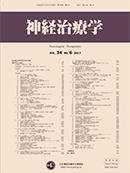Volume 38, Issue 3
Displaying 51-90 of 90 articles from this issue
-
2021 Volume 38 Issue 3 Pages 282
Published: 2021
Released on J-STAGE: January 19, 2022
Download PDF (150K) -
2021 Volume 38 Issue 3 Pages 283-285
Published: 2021
Released on J-STAGE: January 19, 2022
Download PDF (460K)
-
2021 Volume 38 Issue 3 Pages 286
Published: 2021
Released on J-STAGE: January 19, 2022
Download PDF (267K) -
2021 Volume 38 Issue 3 Pages 287
Published: 2021
Released on J-STAGE: January 19, 2022
Download PDF (225K) -
2021 Volume 38 Issue 3 Pages 288-291
Published: 2021
Released on J-STAGE: January 19, 2022
Download PDF (456K) -
2021 Volume 38 Issue 3 Pages 292-296
Published: 2021
Released on J-STAGE: January 19, 2022
Download PDF (1172K) -
2021 Volume 38 Issue 3 Pages 297-300
Published: 2021
Released on J-STAGE: January 19, 2022
Download PDF (2191K) -
2021 Volume 38 Issue 3 Pages 301-304
Published: 2021
Released on J-STAGE: January 19, 2022
Download PDF (2714K)
-
2021 Volume 38 Issue 3 Pages 305
Published: 2021
Released on J-STAGE: January 19, 2022
Download PDF (248K) -
2021 Volume 38 Issue 3 Pages 306-310
Published: 2021
Released on J-STAGE: January 19, 2022
Download PDF (628K) -
2021 Volume 38 Issue 3 Pages 311
Published: 2021
Released on J-STAGE: January 19, 2022
Download PDF (179K) -
2021 Volume 38 Issue 3 Pages 312-317
Published: 2021
Released on J-STAGE: January 19, 2022
Download PDF (897K) -
2021 Volume 38 Issue 3 Pages 318
Published: 2021
Released on J-STAGE: January 19, 2022
Download PDF (158K)
-
2021 Volume 38 Issue 3 Pages 319
Published: 2021
Released on J-STAGE: January 19, 2022
Download PDF (317K) -
2021 Volume 38 Issue 3 Pages 320-324
Published: 2021
Released on J-STAGE: January 19, 2022
Download PDF (592K) -
2021 Volume 38 Issue 3 Pages 325-328
Published: 2021
Released on J-STAGE: January 19, 2022
Download PDF (547K) -
2021 Volume 38 Issue 3 Pages 329
Published: 2021
Released on J-STAGE: January 19, 2022
Download PDF (190K) -
2021 Volume 38 Issue 3 Pages 330-335
Published: 2021
Released on J-STAGE: January 19, 2022
Download PDF (1264K)
-
2021 Volume 38 Issue 3 Pages 336
Published: 2021
Released on J-STAGE: January 19, 2022
Download PDF (280K) -
2021 Volume 38 Issue 3 Pages 337-342
Published: 2021
Released on J-STAGE: January 19, 2022
Download PDF (2699K) -
2021 Volume 38 Issue 3 Pages 343-346
Published: 2021
Released on J-STAGE: January 19, 2022
Download PDF (1044K) -
2021 Volume 38 Issue 3 Pages 347-352
Published: 2021
Released on J-STAGE: January 19, 2022
Download PDF (2775K) -
2021 Volume 38 Issue 3 Pages 353
Published: 2021
Released on J-STAGE: January 19, 2022
Download PDF (200K)
-
2021 Volume 38 Issue 3 Pages 354
Published: 2021
Released on J-STAGE: January 19, 2022
Download PDF (286K) -
2021 Volume 38 Issue 3 Pages 355
Published: 2021
Released on J-STAGE: January 19, 2022
Download PDF (165K) -
2021 Volume 38 Issue 3 Pages 356-359
Published: 2021
Released on J-STAGE: January 19, 2022
Download PDF (1647K) -
2021 Volume 38 Issue 3 Pages 360-362
Published: 2021
Released on J-STAGE: January 19, 2022
Download PDF (340K) -
2021 Volume 38 Issue 3 Pages 363-367
Published: 2021
Released on J-STAGE: January 19, 2022
Download PDF (585K) -
2021 Volume 38 Issue 3 Pages 368
Published: 2021
Released on J-STAGE: January 19, 2022
Download PDF (189K)
-
2021 Volume 38 Issue 3 Pages 369
Published: 2021
Released on J-STAGE: January 19, 2022
Download PDF (298K) -
2021 Volume 38 Issue 3 Pages 370-373
Published: 2021
Released on J-STAGE: January 19, 2022
Download PDF (2142K) -
2021 Volume 38 Issue 3 Pages 374-377
Published: 2021
Released on J-STAGE: January 19, 2022
Download PDF (357K) -
2021 Volume 38 Issue 3 Pages 378-383
Published: 2021
Released on J-STAGE: January 19, 2022
Download PDF (782K) -
2021 Volume 38 Issue 3 Pages 384-387
Published: 2021
Released on J-STAGE: January 19, 2022
Download PDF (358K) -
2021 Volume 38 Issue 3 Pages 388-390
Published: 2021
Released on J-STAGE: January 19, 2022
Download PDF (513K)
-
2021 Volume 38 Issue 3 Pages 391-394
Published: 2021
Released on J-STAGE: January 19, 2022
Download PDF (874K) -
2021 Volume 38 Issue 3 Pages 395-398
Published: 2021
Released on J-STAGE: January 19, 2022
Download PDF (954K)
-
2021 Volume 38 Issue 3 Pages 399-402
Published: 2021
Released on J-STAGE: January 19, 2022
Download PDF (332K) -
2021 Volume 38 Issue 3 Pages 403
Published: 2021
Released on J-STAGE: January 19, 2022
Download PDF (149K) -
2021 Volume 38 Issue 3 Pages 404
Published: 2021
Released on J-STAGE: January 19, 2022
Download PDF (135K)
